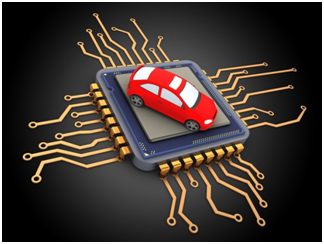 The typical vehicle coming off the assembly line today is equipped with several dozen embedded processors, controlling everything from in-car infotainment systems to vital systems like anti-lock brakes and fuel management. And as you might expect, the more features the car contains, the more microcontrollers it has — high-end luxury cars from BMW and Mercedes, for instance, each have more than 100 different embedded processors on board.
The typical vehicle coming off the assembly line today is equipped with several dozen embedded processors, controlling everything from in-car infotainment systems to vital systems like anti-lock brakes and fuel management. And as you might expect, the more features the car contains, the more microcontrollers it has — high-end luxury cars from BMW and Mercedes, for instance, each have more than 100 different embedded processors on board.
This is a far cry from the early days of adding computers into cars. In fact, the very first car to feature a microcontroller was the 1978 Cadillac Seville, which contained a single chip that powered the in-dash trip computer. Nowadays, we have processors capable of determining not only how far we’ve traveled, but also our gas mileage, how many miles we can travel before we need fuel, what time we will arrive at our destination, and other important information. In fact, most of the key elements of any vehicle are controlled by processors rather than mechanical elements, which not only makes cars safer and more efficient to rive, but also reduces the overall cost of manufacturing them.
Although there are many different types of microcontrollers, you’re more likely to find 8-bit, 16-bit, or 32-bit controllers in cars. And while 32-bit is quickly becoming the standard for many applications, 16-bit microcontrollers aren’t even close to becoming obsolete.
Where You Might Find a 16-Bit Microcontroller
While the IoT is creating a surge in demand for microcontrollers, the automotive industry still represents about half of the market. While many auto manufacturers are moving toward using 32-bit microprocessors, the 16-bit microcontroller is still in use for specific automotive functions thanks to their advantages in terms of math and real-time applications and the fact that they do not provide more power than is necessary to operate specific systems.
Again, while other processers may be more powerful overall, the 16-bit chip is usually enough to power the specific system without taking up too much space or using too much power. Most 16-bit processors are also digital signal converters or processors (DSC/DSP), which allows them to process the data collected by the various sensors within the vehicle and control the appropriate system.
So where might you find these processors in a vehicle?
- MSR (Motor Slip Regulation), also known as engine drag torque control, a safety technology that prevents a car from skidding by keeping the wheels from locking even when the driver rapidly reduces speed by maintaining the torque to the engine.
- ABS (Antilock Braking Systems), which keeps the wheels from locking up when the driver brakes rapidly or on slippery conditions.
- EDS (Electronic Differential Systems), which allow for different wheel speeds.
- Traction Control Systems, which helps prevent a loss of traction when the engine torque doesn’t match road conditions, such as when trying to accelerate on snowy roads.
- Remote controlled door locks and alarms.
- In-car infotainment systems, including GPS and Wi-Fi.
These are just some of the systems where you would find microcontrollers in your vehicle — and automotive engineers are working on new technologies that will make even greater use of them.
 What’s on the Horizon
What’s on the Horizon
Microprocessors are a key part of ongoing efforts to improve the safety of vehicles. Not only are they a key part of vehicle dynamics and stability systems, but they also control such important features as airbag systems. Modern airbag sensors are capable, for example, of determining where passengers are sitting in the vehicle in order to properly deploy airbags in the event of a crash.
Engineers are also looking at ways to use microchips to reduce the fuel consumption of vehicles and reduce their overall carbon footprint. With that goal in mind, electronic components are being put to use to optimize gear ratios and gear shifting, while also controlling components to reduce friction and improve overall efficiency.
In many ways, modern vehicles are little more than computers on wheels. While there are some drawbacks to using microcontrollers throughout the vehicle, namely in the realm of troubleshooting and accessing systems to make repairs, the benefits of these systems cannot be overstated when talking about safety and performance. So even as the IoT becomes a dominant force in our lives, the automotive industry will still be one of the primary markets for microprocessors.







